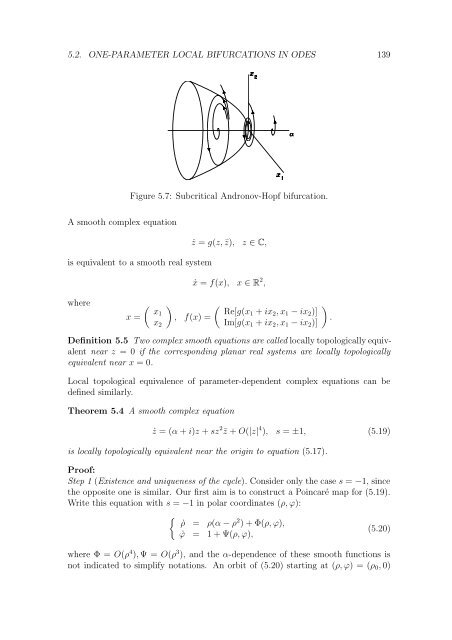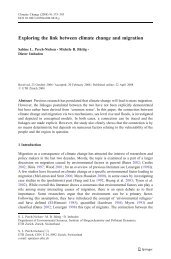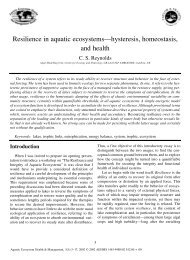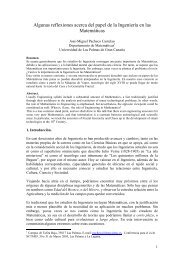5.2.2 Planar Andronov-Hopf bifurcation
5.2.2 Planar Andronov-Hopf bifurcation
5.2.2 Planar Andronov-Hopf bifurcation
Create successful ePaper yourself
Turn your PDF publications into a flip-book with our unique Google optimized e-Paper software.
5.2. ONE-PARAMETER LOCAL BIFURCATIONS IN ODES 139<br />
Figure 5.7: Subcritical <strong>Andronov</strong>-<strong>Hopf</strong> <strong>bifurcation</strong>.<br />
A smooth complex equation<br />
ż = g(z, ¯z), z ∈ C,<br />
is equivalent to a smooth real system<br />
ẋ = f(x), x ∈ R 2 ,<br />
where<br />
x =<br />
(<br />
x1<br />
x 2<br />
)<br />
, f(x) =<br />
( Re[g(x1 + ix 2 , x 1 − ix 2 )]<br />
Im[g(x 1 + ix 2 , x 1 − ix 2 )]<br />
)<br />
.<br />
Definition 5.5 Two complex smooth equations are called locally topologically equivalent<br />
near z = 0 if the corresponding planar real systems are locally topologically<br />
equivalent near x = 0.<br />
Local topological equivalence of parameter-dependent complex equations can be<br />
defined similarly.<br />
Theorem 5.4 A smooth complex equation<br />
ż = (α + i)z + sz 2¯z + O(|z| 4 ), s = ±1, (5.19)<br />
is locally topologically equivalent near the origin to equation (5.17).<br />
Proof:<br />
Step 1 (Existence and uniqueness of the cycle). Consider only the case s = −1, since<br />
the opposite one is similar. Our first aim is to construct a Poincaré map for (5.19).<br />
Write this equation with s = −1 in polar coordinates (ρ, ϕ):<br />
{<br />
˙ρ = ρ(α − ρ 2 ) + Φ(ρ, ϕ),<br />
(5.20)<br />
˙ϕ = 1 + Ψ(ρ, ϕ),<br />
where Φ = O(ρ 4 ), Ψ = O(ρ 3 ), and the α-dependence of these smooth functions is<br />
not indicated to simplify notations. An orbit of (5.20) starting at (ρ, ϕ) = (ρ 0 , 0)






